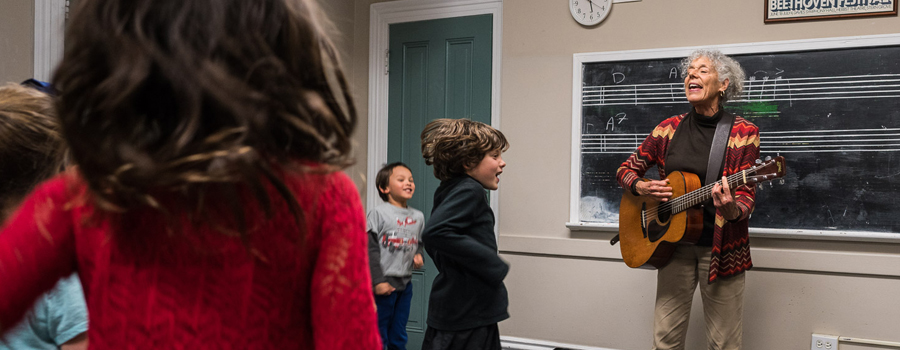For more information on all of CMC’s early childhood education offerings and faculty, visit the Youth Group Classes and Ensembles page.
Irene Chagall: Music for Children Instructor
“I give them (the students) each a piece of string.
I say, ‘We’re studying the string family. How do you make an instrument out of a piece of string?
Take this piece of string home and see what you can come up with.”
-Irene Chagall, Music for Children instructor
By Katy Fox, guest writer

Thus begins the Winter Quarter for students in Irene Chagall’s Music For Children class at the Community Music Center. Over the following weeks, children ages 4-7 will gain direct understanding of how strings create vibration, build their own cuica (Brazilian friction drum), try-out and compare various string instruments. They will dance, they will laugh, and they will play a violin both pizzicato and with a bow. By the time a 12-year old CMC violin student visits their class to give them a demo, they will already know why she first takes out her rosin. And if the children are feeling shy, one of Irene’s puppets will lead the games and songs. By the end of the semester, a certain beloved skunk puppet will have received gifts from many adoring students.
Irene’s curriculum begins by encouraging children to imagine how natural sounds could have inspired the development of instruments. “Maybe it happened because the wind blew in the trees and people said ‘what’s that sound?’ That’s so much more basic than what we think of when we think of ‘symphony.’ It connects music to life experience, to awareness.” For the wind family, she will bring in a blade of grass. To introduce horns, Irene will pass around a seashell and a ram’s horn. If she has slightly older students, she will show off a donkey jaw, commonly used in Brazil.
“My point of departure is the same in all my classes: music as a design made of sound in time. I ‘read’ the group and find the material that they can connect with. If I have a more sophisticated group of children, I’ll do more with rhythm, reading and preparedness for what it takes to actually study an instrument. The teachers I’ve gotten to know at CMC say that the kids who have taken my class are great to have as students because they already have a foundation. That’s really wonderful!”

Irene emphasizes a joyful ensemble, embodying musical vocabulary as a way of learning it, and breaking down complex concepts into digestible parts. Her primary influences are the Orff Approach and Dalcroze method. She was trained in the latter as a child and attributes this early exposure (“I wasn’t aware that I was learning music, but I was really learning music”) to her lifelong work as a self-described minstrel. In the Dalcroze method, children are taught that the body is their first instrument and are encouraged to interpret rhythm, melody and harmony through both specific and spontaneous movement. As a child, Irene remembers marching in quarter notes, jogging in eighth notes, running fast in sixteenth notes, taking huge steps to “get” whole notes.
The Orff Approach to teaching music is modeled on how we learn our native tongue. It’s focus on immersive, imaginative group learning is what Irene loves most. “To get a group of children laughing and moving their bodies and experimenting and finding their limits—that is what makes this work. It is universally human to respond to rhythm. We synchronize to each other.” (This concept is Irene’s soapbox. As a recent research associate at the Smithsonian, she wrote and co-directed Let’s Get the Rhythm, an acclaimed documentary on hand-clapping games from around the world.)
Irene Chagall has been teaching at CMC for 35 years. Though initially encouraged to pursue a career in the sciences, Irene’s gravitational pull has always been music and the arts. She pursued an independent study of classical guitar in Spain, traveled through Northern Africa and came back to the States to get a teaching degree. “The deal is that CMC felt like home from the beginning…it was a place where I could be myself and grow as well, and I have. The mission of the institute is just something I believe in. The beauty of CMC is that the classes are small enough that you can give individual attention, without making a child feel like they’re being singled out…Now too, with the new director, it’s rejuvenating. It’s warm and welcoming, it’s a sanctuary.”
Thank you to Katy Fox the guest writer for this article. The article is part of an interview and article series about early childhood education faculty at CMC.



